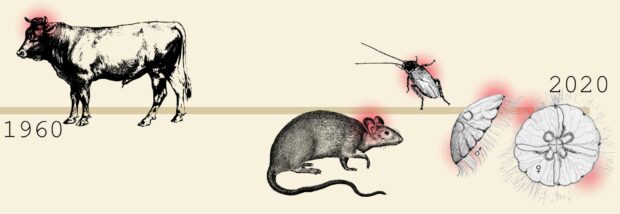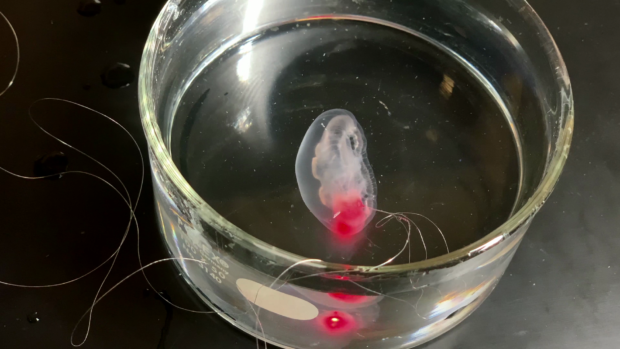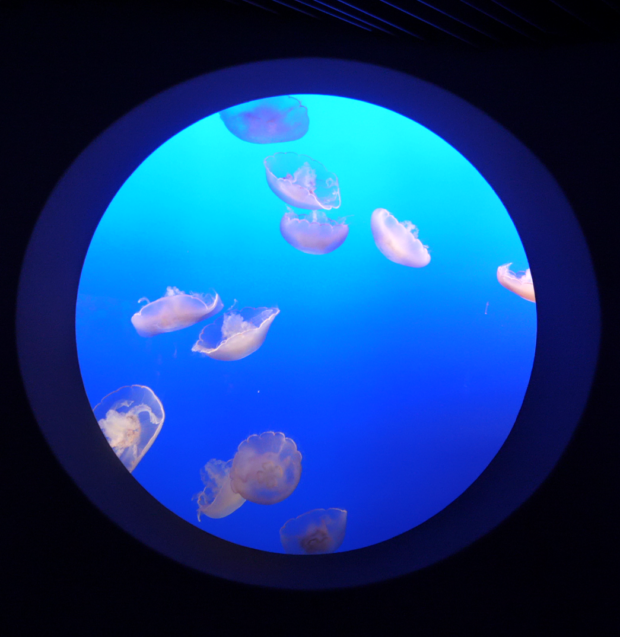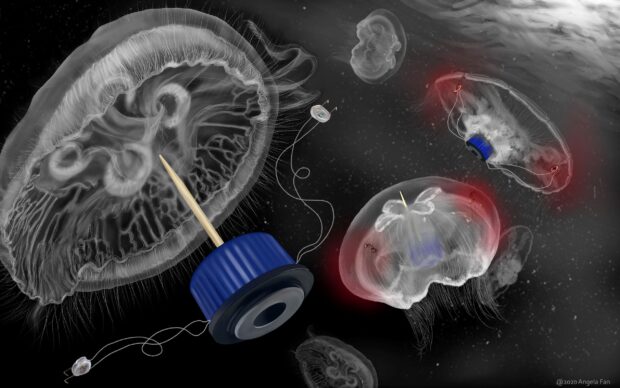Are we ready for this jelly?
Cyborg jellyfish enter the emerging world of biohybrid robots. Reported by Lara Streiff.
Illustrations by Julia Beery and Angela Fan.
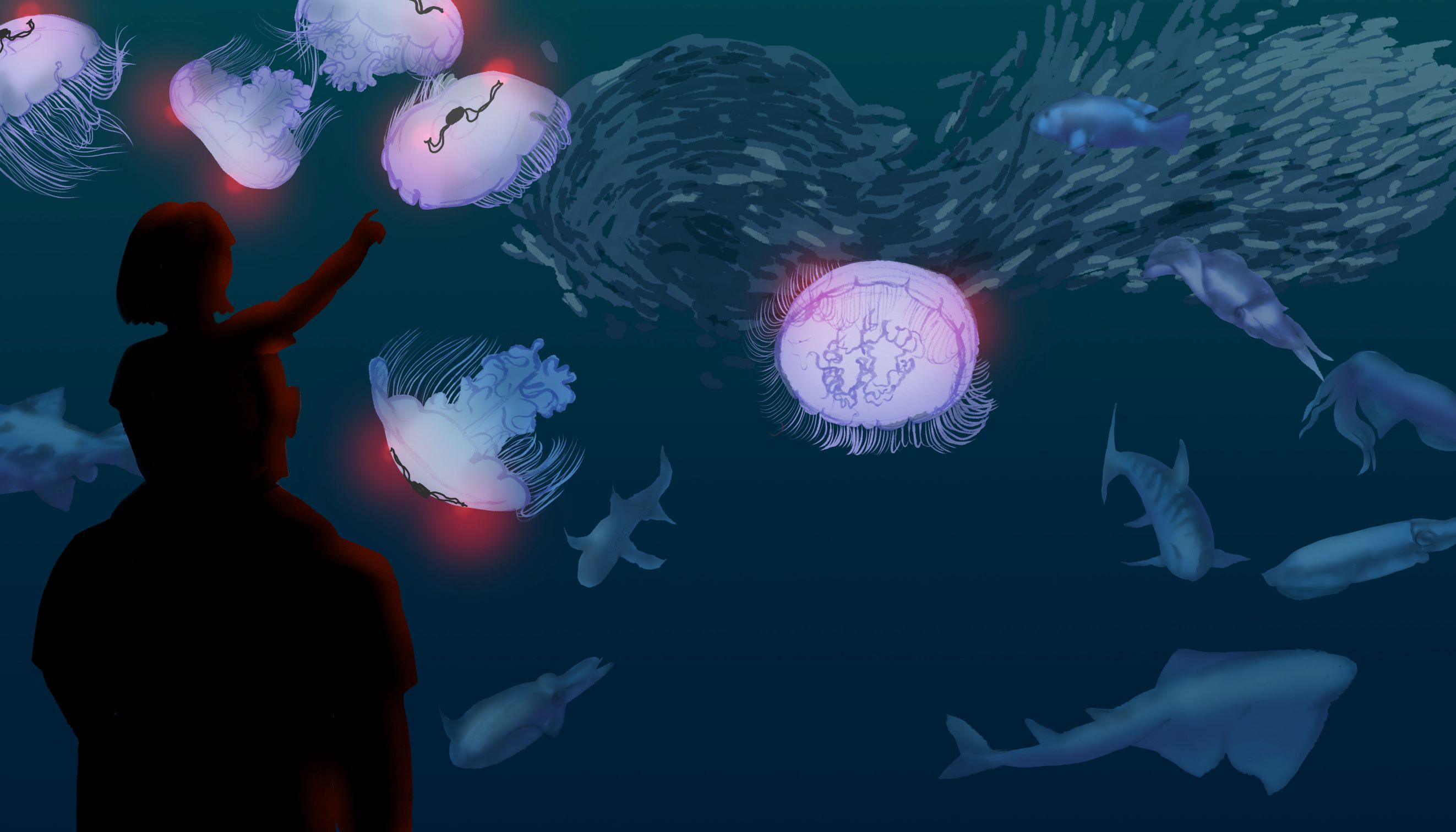
Illustration: Julia Beery
On a beach in Woods Hole, Massachusetts, Stanford bioengineer Nicole Xu opened a Styrofoam cooler filled with moon jellyfish. As the first peach-sized jelly was plopped into the water just a few feet from shore, tiny fish began to dart around it; their silver scales flashing. A flash of a different kind – a bright red LED – lit up from inside the jelly’s transparent body. An embedded chip in the jelly’s disc-shaped bell transmitted electrical signals to the animal’s muscle; the bell contracted. Xu needn’t worry that this test subject would get away; she was controlling its swimming.
Typically dwelling thousands of meters below the surface of the sea, gelatinous moon jellies aren’t naturally found so close to the shoreline. They prefer calmer depths, far from forceful winds and waves. The newly deployed jelly continued to pulse, and the red LED continued to blink as Xu proved her theory — her robot-jellyfish hybrids can survive in the ocean.
Moon jellies thrive all over the world; in balmy tropic waters, chilly arctic seas, renowned aquariums and scientists’ laboratories. They have even survived a trip to outer space. Now Xu is building small microelectronic arrays into their bodies, turning them into cyborgs. These robotic hybrids could someday traverse the world’s oceans — though not of their own volition.
Nicole Xu speaks about her biohybrid jellyfish robots from her lab in Stanford, California.
By implanting living things with synthetically engineered pieces, Xu and scientists like her are creating organisms that fall somewhere between animal and robot.
“The main advantage of biohybrid systems is that they allow us to use the natural muscles of animals as actuators to cause movement,” said George Lauder, professor of organismal and evolutionary biology at Harvard University. Xu’s modified jellies can swim faster and more efficiently than ever before. By implanting living things with synthetically engineered pieces, Xu and scientists like her are creating organisms that fall somewhere between animal and robot.
In doing so, these scientists are exploring the biology of living creatures while also radically advancing robotics. Xu hopes her jellies will someday serve as environmental monitors. Other researchers in this field area are working towards a broader range of applications including search and rescue vehicles, and targeted medical treatments. “A lot of these robots are still running around in petri dishes,” said Victoria Webster-Wood, founder of the Carnegie Mellon University Biohybrid and Organic Robotics Group. But every so often the science surges forward.
A history of animal-robot hybrids
Earlier robot-animal hybrids preceded Xu’s cyborg jelly. In the 1960s a Spanish neuroscientist named Jose Delgado stunned the world when he entered an arena, taunted a bull, and stopped it mid-charge by the press of a button on a remote control. The button stimulated a neural implant, sending electrical impulses into the bull’s caudate nucleus — the area of the brain that controls movement. Delgado’s stunt demonstrated the power of neural stimulation and teased the first step toward biohybrids.
A few decades later, a team of neuroscientists in New York placed a similar implant into a rat’s brain. By stimulating the implant, the researchers guided the rat’s movements through an obstacle course, creating their very own “robo-rat”. A team in Michigan followed suit with the first commercially available DIY cyborg kit roughly ten years later, bringing the “Roboroach” to commercial markets and people’s backyards. Young customers interested in neuroscience or bioengineering who purchased a kit – cockroach not included – could perform a quick surgery to implant microelectronics into a roach’s antennae and then wirelessly direct it to the left or right.
However, Xu had to contend with an additional challenge — her subjects survive solely underwater. The robotic components needed to function inside a creature that has the same water content as a tomato and its saltwater habitat. “Stimulation in marine environments, on soft animals, is tricky,” said Roboroach creator Timothy Marzullo. But even five years ago both Xu and her advisor John Dabiri, now the Centennial Chair Professor at the California Institute of Technology, weren’t deterred from developing biohybrids that could help them learn more about the ocean. Xu was already interested in the marriage of biology and engineering while attending the University of Pennsylvania as an undergraduate student; A summer research program introduced to her to Dabiri’s lab.
In a joint project between Harvard and Caltech, the lab had created a “medusoid” — a jelly-like biological robot. Dabiri and his collaborators from Harvard University had arranged rat heart cells on a silicon mold shaped like an eight-petaled flower. When they ran electrical current through the medusoid, it pulsed just like a jellyfish. The Harvard team later adapted the same cardiac cell technique to create a light-sensitive swimming ray.
But these “petri-dish-robots” can’t survive outside the lab. Both Xu and Dabiri wanted to integrate electronics into a live animal, not just cells or tissues, so that it could function in the real world. That desire became the central focus of Xu’s graduate research in Dabiri’s lab, first at Caltech, and then Stanford University a few years later.
From imagination to reality
Below the warm stone arches and scatterings of palm trees at Stanford University‘s Palo Alto campus lie a host of underground laboratories. Xu’s gauzy moon jellies swirl around a saltwater tank in the basement level of the school’s Energy and Environment building. Despite contracting their bodies in slow, graceful pulses, the jellies succumb to the current that circulates them in the glass case.
“Everyone asks me: ‘Why jellyfish?’,” said Xu. “’Why not choose something like a fish, or a dolphin, or a shark; something that’s faster?’ Energy efficiency is the answer.”
Xu quantifies jelly efficiency through the animals’ “cost of transport” — a measure that essentially tells her how many miles to the gallon they can get. When comparing to other animals, a low cost of transport means the jellies expend less energy for traveling the same distance. When comparing to other underwater robots, Xu’s cyborgs are 10 to 1,000 times more energy efficient because very little external power is required.
Xu then chose her jelly species Aurelia aurita, also called Moon Jellies, out of convenience. According to collaborator John Costello, a biology professor at Providence College, A. aurita is studied more than any other jelly species. Moon jellies are found worldwide and can easily be raised in a lab environment. Though jellies are known to sting, Xu has never suffered any — the moon jelly’s stinging cells cannot penetrate thick human skin. The animals don’t feel pain themselves because they have no brain or pain receptors. Individual jellies range from quarter- to dinner plate-size, and Xu buys hers locally from the Cabrillo Aquarium.
The microelectronic system is made of inexpensive, off-the-shelf and upcycled parts. The piece that does the actual computing is a microprocessor chip smaller than a grain of white rice and costs about $.30. It is connected to a battery and two electrodes equipped with small red LED lights. The chip rests on a test-tube cap that might have otherwise been tossed and is imbedded in each jelly with a toothpick. The toothpick’s natural barbs help hold the device in place, in an animal that is 95% water and has the consistency of, well, jelly.
Xu calls the microelectronic device a self-contained swim controller. She can program it to a specific frequency to jolt a jelly’s muscle and change its swimming speeds, much like muscle stimulation machines used in physical therapy. The blinking LEDs confirm that an electrical signal is transmitting.
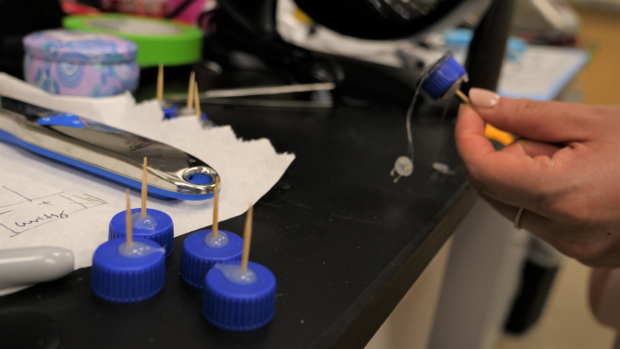
Xu’s lab bench features toothpicks and bottlecaps, both essential components for her microelectronic device. Credit: Lara Streiff
Ethan Li, a doctoral student in the bioengineering department, helped work around the challenges of using tiny components and keeping the electronics functioning. Li struggled with soldering the tiny circuit boards and .15 mm diameter electrode wiring, so thin and light that it was initially mistaken for glue strings from a hot glue gun. Because saltwater conducts electricity, Li also tested several watertight ways of packing the microchip to prevent the risk of short-circuiting.
For Xu’s tank tests, the microelectronics proved hardy enough. The moon jellies swam up to three times faster with the implant, at only twice the energetic cost. Though it seems counter-intuitive that jellies don’t swim at this higher efficiency naturally, Costello hints that jelly hydrodynamics are more complex. These delicate animals don’t have the luxury of strong muscles. Instead, jellies contract their bells to create vortices that propel them forward, even when their bodies are relaxed in between pulses. But if pulsing accelerates, like when prompted by the electronics, their vortex riding gets cut off prematurely.

The biohybrid jelly swims faster and more efficiently than the jelly with an inactive microelectronic device. Credit: Caltech
Costello said that Xu and Dabiri’s work has already contributed important knowledge about how jellies move and swim. Combining live animals with robots makes it possible to learn more about biology and animal behavior, as well as advancing robotics. “I’m not sure we can make progress without doing these things,” Costello said.
A question of ethics
Invertebrates like insects and jellyfish, are appealing test subjects because they’re not restricted under federal laws and regulations. The Institutional Animal Care and Use Committees (IACUCs) consider invertebrates as two major groups: one worthy of increased moral concern — like vertebrates receive – which includes octopus and some crustaceans; the rest which are therefore not deemed worthy of increased moral concern. In some jurisdictions, invertebrates do not even meet the legal definition of “animal,” according to Hank Greely, a scientific ethics expert at Stanford University.
But animal or not, (animals—they are definitely animals) the scientific community has received these and other biohybrid robots with more excitement than concern. Most criticism, if any, comes from the general public. The Roboroach seems to have received the most, likely because of its commercialization. In an article for Wired, writer Liat Clark equated the DIY kit to a grown-up version of burning ants with a magnifying glass. But the creators say their aim is simply to make science more accessible and exciting. Marzullo counted more than 80 articles written about the kit since its launch; they succeeded in exciting the media at the very least.
“There might come the point where we are crossing a line, but I don’t think we’re there yet,” said Costello.
“There might come the point where we are crossing a line, but I don’t think we’re there yet,” said Costello. Animals continue to be a common component of scientific research, though some research can be perceived as more pertinent or valuable. Greely stated that while the public generally cuts medical research more slack, he didn’t anticipate a strong reaction to biohybrids unless the animal involved appeared to be in pain.
Despite this, Xu and Dabiri took special care of their jellies when stimulating them. “We want to leverage biology and we want to respect biology as well,” said Dabiri. The team measured the metabolic rate of each jelly as a proxy for stress. Andrés Carrillo, Research Curator for Cabrillo Aquarium who oversees the jelly lab which provided Xu’s jellies, said that the Aquarium prefers this type of research over many studies. “Jellies are quite remarkable in how they heal, as long as they are taken care of appropriately,” said Carrillo.
Another source of concern is the environment that biohybrids are deployed into. Though biohybrid jellies don’t create noise or light pollution that other robots can’t avoid, a robotic jelly that dies or loses its electronics becomes litter in the sea. One option Dabiri has considered is to swap the electronic system with biodegradable alternatives.
For now, the team ensures that every device makes it back into the lab. The hardware needs to be modified before full ocean deployment regardless; because while fully waterproof microelectronics exist— these are not that. If researchers hope to collect any data, they will also need to attach the proper sensors. The foray of those first jellies into the Atlantic only proved that they could someday be up to that task.
Engineering with biology
“It’s simpler to harden the electronics than engineer a new vehicle,” said Dabiri; there are no engineered materials that can compete with biology — yet. To be fair, animals’ have evolved their abilities over thousands of years. Scientists may need a little more time for evolving their robotic designs.
“People don’t realize that this is even an option on the table,” said Xu. Leveraging the natural capabilities of animals is a workaround for designing all the components of a new robot from scratch. There are some tradeoffs in the biohybrid approach, as there are in traditional and biologically based robotics. Lauder believes the main purpose behind the development and use of robots is that you have full control over the movements that are produced, that is not the case for Xu’s jellies.
“For purely mechanical robots, you can really design the inputs and outputs,” said Xu, “so you don’t run into issues of, the jellyfish is going to be doing its own thing as well.” Animals can provide a lot of their own energy supply through their natural feeding processes, but that also means a jelly’s got to eat, and the scientists must let them.
Engineering with biology, but just using tissues and cells, can avoid some pesky animal behaviors and still reap some of the benefits. Ritu Raman, a postdoctoral fellow at MIT, has added biology into her robots, which now get stronger from exercise and heal when damaged. “These behaviors have not been observed in robots made with traditional synthetic materials and proved that building with biology can and does make a big difference,” said Raman. Because her robots are intended for medical applications, using cells as building blocks also ensures that the “biobot” will be compatible with its target environment: the body.
For ocean environments, oceanographers and marine biologists today use research vessels, AUVs (autonomous underwater vehicles) and ROVs (remotely operated vehicles). But Xu and Dabiri’s jellies could offer more cost-effective, farther-reaching, and less invasive bio-monitors. By utilizing a natural presence like a jellyfish, scientists get rid of the element of disruption, and may collect data that other underwater robots cannot.
Both biology-based and biohybrid robots are best suited for applications where having flexibility is an advantage. “Traditional roboticists prefer total predictability, which is never something we will be able to do,” said Webster-Wood.
But even those who stick exclusively to engineered materials can recognize the advantages of being a little flexible. It’s driven bio-mimetic design and development of “soft robots”, which are inspired by soft-bodied animals to be deformable and adaptable. Webster-Wood said that for movement in any terrain, “it’s important that animals are a little squishy.” Jellies just classify as a lot squishy.
Xu and Dabiri are both continuing with robotic jelly research. The team is now improving the jellies’ maneuverability by tinkering with their electrode placement. According to Xu, directing the animals through an obstacle course would be the next major milestone toward mission-ready jellies. Both Xu and Dabiri imagine that a smack of jellies, outfitted with sensors, could one day deploy with a specific data-collecting goal, like monitoring temperatures or capturing video footage. “I think there is a space for all of these different types of robots,” said Xu. Perhaps her jellies will be entering an ocean teeming with various other creations that span the whole spectrum of robotic and living.

Lara Streiff
Author
B.S. (environmental systems, ecology, behavior, and evolution track) University of California, San Diego
Internships: Stanford University News Service, Monterey Bay Aquarium Research Institute, Monterey Herald
I distributed flashlights as the sun set into the Indian Ocean, leading a few novice snorkelers into our island’s lagoon. I’d warned the snorkelers to be careful with their lights. But as they hit the water, their arms started flailing, strobing the reef below.
I felt a hefty thump on my left, knocking me sideways to see a large brownish-gray form darting past me—a massive nurse shark— most likely blinded by our lights. When I explained this to the snorkelers, they grew quiet, realizing that they had disturbed the shark and put us all at risk.
As a science writer, I hope to do the same thing on a larger scale: to use storytelling to increase awareness of the world around us, and prevent environmental harm.

Julia Beery
Illustrator
B.F.A (museum conservation) New Mexico State University
Internship: Studio Abachar, MesoAmerican Research Center at UC Santa Barbara
Julia revels in observing the structure of plants and fungi, and recording her observations inwatercolor. She has recently branched out into the digital world to create translucent gemlikenudibranchs. After completing the program she has moved back to the Bay Area, where shehopes to contribute to a healthy community of artists and scientists. To de-stress after a day ofillustrating Julia likes to bake bread and go on runs with her dog Minnow.

Angela Fan
Illustrator
B.S. (architecture and interior desig) San Francisco
Internship: The Center for BioMedical Visualization for St. George University, Grenada, W.I.; Justine Lee Hirten Studio
Angela has always had a need for artistic expression, exercised through all forms of media from charcoal pencil sketches to oil paintings. She captured the natural world around her as she saw it in pencil and paint. She emigrated from Wuhan, China, to San Francisco, California whereShestudiedArchitecture and Interior Design (B.S.) before finding her way back to her childhood artistic roots. She is currently in process of getting her graduate certificate in ScienceIllustration at California State University in Monterey Bay. Science illustration, as afield, is broad in subject and media but always has the goal of accuracy and communication: from rendering the rough texture of lichen in colored pencils to rendering the colors of the iridescent Asian jewel beetle shell in Adobe Photoshop &Illustrator.She thoroughly enjoys the variety and challenges of art and illustration
